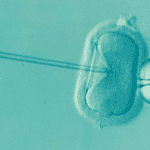In today’s paper: a white Ohio woman, Jennifer Cramblett, is suing a suburban Chicago sperm bank because, due to a misreading of the handwritten order, she gave birth to a biracial child.
Cramblett is suing Midwest Sperm Bank for wrongful birth and breach of warranty, citing the emotional and economic losses she has suffered.
She had her lesbian partner say that, while they love the child and are themselves not racist,
“[she] lives each day with fears, anxieties and uncertainty about her future and Payton’s future.”
Raising a mixed-race daughter has been stressful in Cramblett and Zinkon’s small, all-white community, according to the suit.
Among other difficulties, the suit cites the need to go to a black neighborhood to get the child’s hair cut, the fear that her family is “unconsciously insensitive,” and “stress and anxiety . . . when she envisions Payton entering an all-white school.” She also sees multiple therapists, who have advised the family to relocate to a racially diverse area.
How did the mix-up happen? Crain’s provides more detail: The lesbian couple had selected donor #380 and received vials of sperm. While pregnant, she called to order more sperm and discovered that the sperm bank had read “380” as “330.” After the mixup was discovered,
She later discovered that the sperm bank keeps paper, not electronic records, the suit alleges. “To the person who sent Jennifer vials of sperm in September 2011, the number ‘380’ looked like ‘330,’ and there are no redundancies to catch errors like the one the defendant made with respect to Jennifer Cramblett,” says the complaint, which seeks monetary damages.
Now, it’s not clear to me whose fault this is, really. It seems as if the issue is not with electronic vs. paper records but with the fact that the order form was filled out by hand. Is the suit actually alleging that ordering should have taken place online? That the form should have been designed in such a way as to require the customer to fill out the requested donor number twice for clarity’s sake, in the same way as resetting passwords are entered twice? For that matter, did the 380 look like a 330?
And when the sperm was delivered, was it not labeled in any way? Or did the customers fail to check the labeling at any point after they’d received it? Because you’d think that, if the product had no labels, this would be the key fact, not the lack of electronic records.
But besides that — what liability does a company have for not fulfilling a product order correctly? Both Crain’s and the Tribune report that the sperm bank refunded the cost of the sperm. What kind of warranty does a sperm bank offer, or in what way are they liable for their product?
In the end, this is another illustration of the harm of viewing children as commodities, to be manufactured as desired by the parents, or intended parents. This isn’t as extreme as intended-parents contracting with a surrogate demanding that she abort a baby with a health issue, or get rid of multiples, but it’s part of the same story.
(I tried to see if there were similar instances in the past. There was one, in the New York Times, back in 1990, but with no report of the outcome of the lawsuit.)
UPDATE: I had commented on the Crain’s article on their site, and now there’s a follow-up comment:
When I went through similar procedures, I was required by the doctor/clinic to verify the donor number on the vial each time, and sign paperwork stating I had checked this. Even if their doctor didn’t follow this procedure, they should have asked.
And both articles say that the doctor/clinic isn’t a party to the lawsuit. Perhaps that doctor is a family friend, or doesn’t have deep pockets, or possibly any pockets at all, or perhaps this was actually a DIY insemination and they themselves failed to check the vials?
Another update: here’s the PDF of the lawsuit. And indeed the donor number was written on the vials itself, according to the complaint itself, since it gives as a chronology insemination of multiple vials over multiple months, with one remaining vial, which was confirmed to be that of the wrong donor after the mixup was uncovered. So seven times she was inseminated with no effort to confirm the donor number.












